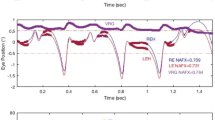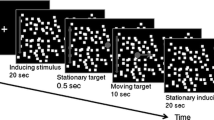Summary
Optokinetic nystagmus in the four principal directions was investigated on the occurrence of directional asymmetries in 7 normal human subjects. Instructions were aimed at obtaining a ‘stare’ type of OKN. The movement of both eyes was recorded simultaneously with a scleral sensor-coil method. Subjects viewed a full-field random dot pattern rotating at velocities of 9 to 57 deg/s binocularly, as well as monocularly with either eye. Gain was always less than 0.85 and decreased when the pattern velocity increased. Horizontal and vertical nystagmus differed in a number of respects. (1) We found no evidence for an overall asymmetry for rightward or leftward, motion. However, human OKN showed a clear preference for upward stimulus motion. Mean gain was ca. 0.15 larger for upward than for downward motion. (2) The decrease of the gain of OKN as a function of increasing stimulus velocity was steeper for vertical than for the horizontal direction. (3) The eyes moved nearly perfectly yoked for vertical pattern movement, irrespective of the viewing conditions. In contrast, during horizontal OKN the gain of the eye tracking in the nasal direction was higher (by about 4%) than the gain of the other eye moving simultaneously in the temporal direction. This difference persisted irrespective of the viewing conditions and appears to be motor, not sensory in origin. In addition, for any direction of the pattern motion a statistically significant increase of the gain occurred when the pattern motion was seen binocularly instead of monocularly with either eye.
Similar content being viewed by others
References
Baloh RW, Richman L, Yee RD, Honrubia V (1983) The dynamics of vertical eye movements in normal human subjects. Aviat Space Environ Med 54: 32–38
Barry W, Melvill-Jones G (1965) Influence of eye lid movement upon electro-oculographic recordings of vertical eye movements. Aerospace Med 36: 855–858
Collewijn H (1969) Optokinetic eye movements in the rabbit: input-output relations. Vision Res 9: 117–132
Collewijn H (1975) Direction-selective units in the rabbit's nucleus of the optic tract. Brain Res 100: 489–508
Collewijn H, Tamminga EP (1984) Human smooth pursuit of different target motions on different backgrounds. J Physiol (Lond) 351: 217–250
Collewijn H, Van der Steen J, Steinman RM (1985) Human eye movements associated with blinks and prolonged eyelid closure. J Neurophysiol 54: 11–27
Collins WE, Schroeder DJ, Rice N, Mertens RA, Kranz G (1970) Some characteristics of optokinetic eye-movement patterns: a comparative study. Aerospace Med 41: 1251–1262
Cynader M, Harris L (1980) Eye movement in strabismic cats. Nature 286: 64–65
Erickson RG, Barmack NH (1980) A comparison of the horizontal and the vertical optokinetic reflexes of the rabbit. Exp Brain Res 40: 448–456
Hess BJM, Precht W, Reber A, Gazin L (1985) Horizontal optokinetic ocular nystagmus in the pigmented rabbit. Neuroscience 15: 97–107
Hoffmann KP (1982) Cortical versus subcortical contributions to the optokinetic reflex in the cat. In: Lennerstrand G, Zee DS, Keller EL (eds) Functional basis of ocular motility disorders. Pergamon Press, Oxford, pp 303–310
Hoffmann KP, Distler C (1986) The role of direction selective cells in the nucleus of the optic tract of cat and monkey during optokinetic nystagmus. In: Keller EL, Zee DS (eds) Adaptive processes in visual and oculomotor systems. Pergamon Press, Oxford, pp 261–266
King WM, Leigh RJ (1982) Physiology of vertical phase. In: Lennerstrand G, Zee DS, Keller EL (eds) Functional basis of ocular motility disorders. Pergamon Press, Oxford, pp 267–276
Kömpf D, Pasik T, Pasik P, Bender MB (1979) Downward gaze in monkeys stimulation and lesion studies. Brain 102: 527–558
Matsuo V, Cohen B (1984) Vertical optokinetic nystagmus and vestibular nystagmus in the monkey: up-down asymmetry and effects of gravity. Exp Brain Res 53: 197–216
Pola J, Wyatt HJ (1985) Active and passive smooth eye movements: effects of stimulus size and location. Vision Res 25: 1063–1076
Ranalli PJ, Sharpe JA (1987) Vertical vestibulo-ocular reflex, smooth pursuit and eye-head tracking in normal subjects. ARVO 28: 315
Schlag J, Merker B, Schlag-Rey M (1983) Comparison of EOG and search coil techniques in long-term measurements of eye position in alert monkey and cat. Vision Res 23: 1025–1030
Schor C, Narayan V (1981) The influence of field size upon the spatial frequency response of optokinetic nystagmus. Vision Res 21: 985–994
Takahashi M, Igarashi M (1977) Comparison of vertical and horizontal optokinetic nystagmus in the squirrel monkey. ORL 39: 321–329
Takahashi M, Sakurai S, Kanzaki J (1978) Horizontal and vertical optokinetic nystagmus in man. ORL 40: 43–52
Van den Berg AV, Collewijn H (1986) Human smooth pursuit: effects of stimulus extent and of spatial and temporal constraints of the pursuit trajectory. Vision Res 26: 1209–1222
Van Die G, Collewijn H (1982) Optokinetic nystagmus in man: role of central and peripheral retina and occurrence of asymmetries. Human Neurobiol 1: 111–119
Wallman J, Velez J (1985) Directional asymmetries of optokinetic nystagmus: developmental changes and relation to the accessory optic system and to the vestibular system. J Neurosci 5: 317–329
Westall CA, Schor CM (1985) Asymmetries of optokinetic nystagmus in amblyopia: the effect of selected retinal stimulation. Vision Res 25: 1431–1438
Author information
Authors and Affiliations
Rights and permissions
About this article
Cite this article
van den Berg, A.V., Collewijn, H. Directional asymmetries of human optokinetic nystagmus. Exp Brain Res 70, 597–604 (1988). https://doi.org/10.1007/BF00247608
Received:
Accepted:
Issue Date:
DOI: https://doi.org/10.1007/BF00247608




